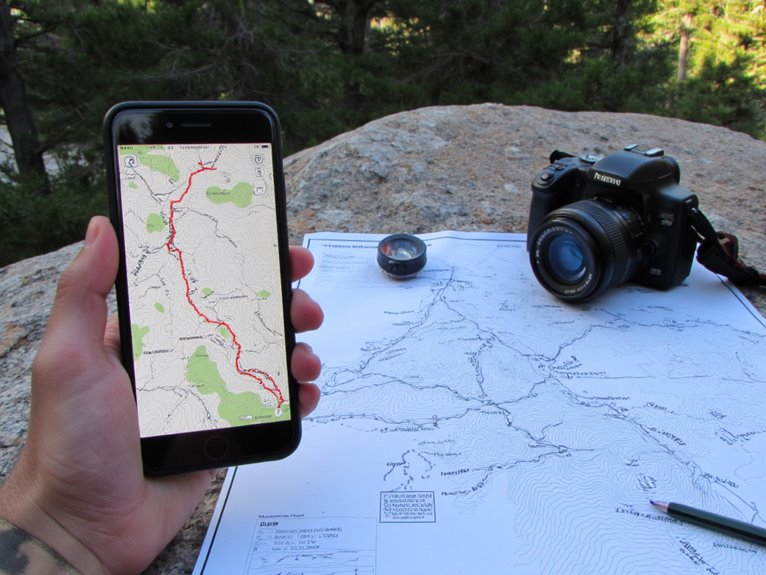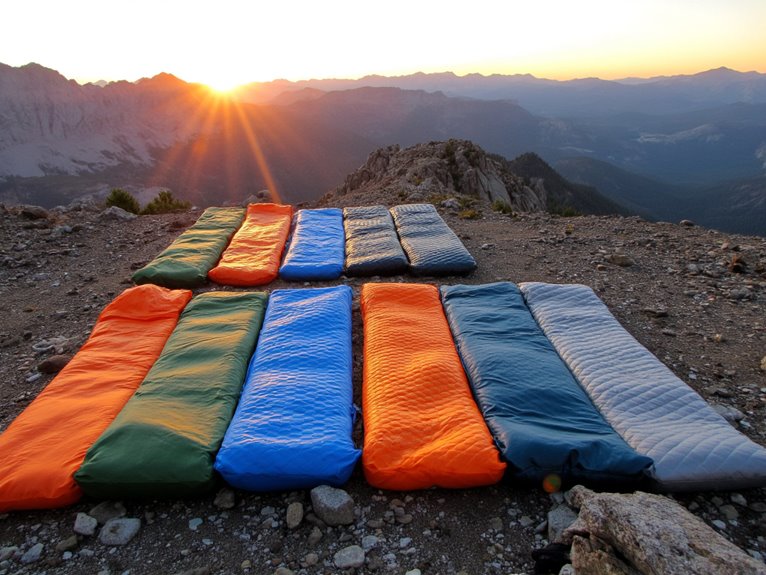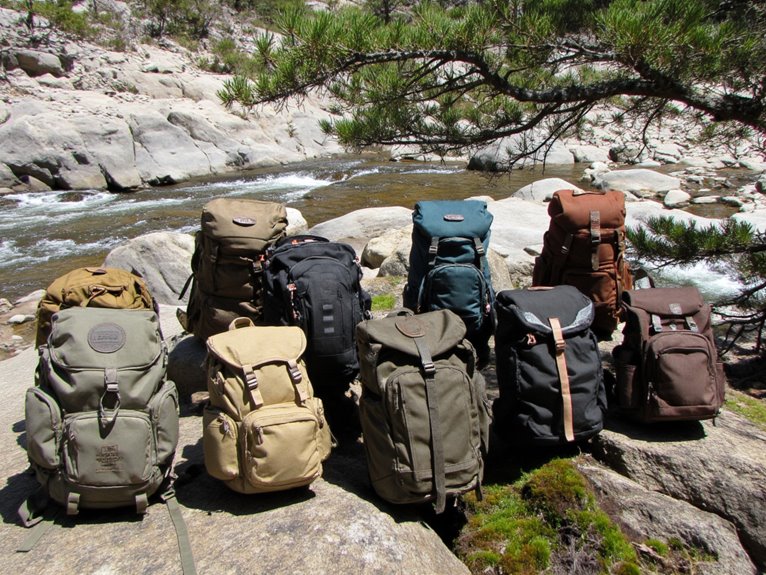How Much Water Do I Need for 5 Days Camping?
For a 5-day camping trip, a general guideline is to plan for at least 1 gallon of water per person per day, translating to 5 gallons per person. This accounts for drinking, cooking, and hygiene. However, individual factors like age, sex, and physical activity level can impact water requirements. Climate, altitude, and humidity also play a significant role. By taking these factors into account, you can adjust your water needs accordingly. Understanding your unique water requirements is vital for a safe and enjoyable camping experience. As you prepare for your trip, it's essential to ponder the nuances of water planning to guarantee a safe and successful adventure.
We are supported by our audience. When you purchase through links on our site, we may earn an affiliate commission, at no extra cost for you. Learn more. Last update on 7th January 2026 / Images from Amazon Product Advertising API.
Calculating Your Water Needs
Accurate calculation of water needs is crucial to guarantee a safe and enjoyable camping experience, as inadequate hydration can lead to serious health consequences in the wilderness.
To calculate your water needs, consider the number of people in your group, the duration of your trip, and your individual water requirements.
A general guideline is to plan for at least 1 gallon of water per person per day for drinking, cooking, and hygiene. However, this amount may vary depending on individual factors such as age, sex, and physical activity level.
It's essential to factor in additional water for washing dishes, cleaning wounds, and other unexpected needs.
Climate and Water Requirements
Climate plays a significant role in determining individual water requirements, as varying temperatures and humidity levels drastically impact the body's hydration needs.
When camping in hot and humid climates, the body loses water more rapidly, increasing the need for hydration. In contrast, cooler and drier climates may require less water intake.
To consider the impact of climate on water needs, keep the following factors in mind:
Temperature: Higher temperatures increase water loss through sweating.
Humidity: High humidity reduces sweat evaporation, increasing water loss.
Altitude: Higher elevations lead to increased water loss due to lower air pressure.
Wind: Strong winds accelerate water loss through sweating and evaporation.
Understanding these climate-related factors will help you accurately estimate your water needs for a comfortable and safe camping experience.
Activity Level and Hydration
An individual's activity level also substantially impacts their hydration needs, as physical exertion increases water loss through sweating and respiration.
For campers, this means that engaging in strenuous activities such as hiking, biking, or kayaking will require more water intake to replenish lost fluids.
Conversely, more leisurely activities like reading or lounging will require less.
As a general guideline, campers should add 1.5 to 2 liters of water to their daily intake for every hour of moderate to intense physical activity.
This will help maintain proper hydration and prevent dehydration, ensuring a safe and enjoyable camping experience.
Individual Water Needs Factors
Age, sex, body composition, and overall health are additional factors that influence an individual's water needs, with certain demographics requiring more water due to their unique physiological characteristics.
When planning your camping trip, consider the following individual factors that impact water needs:
Pregnancy and breastfeeding: Women who are pregnant or breastfeeding require more water due to increased fluid needs.
Older adults: As people age, their bodies naturally lose water content, making it essential to drink more water.
Obesity: Individuals with a higher body mass index (BMI) may require more water due to their larger body size.
Chronic health conditions: Certain conditions, such as diabetes or kidney disease, may necessitate increased water intake.
Camping Environment and Water
When camping, the environment plays a significant role in determining water needs.
Climate and humidity levels, water sources availability, and altitude and elevation all impact the amount of water required for a safe and comfortable camping experience.
Understanding these environmental factors is essential to estimating the right amount of water to bring along on a camping trip.
Climate and Humidity Levels
Climate and humidity levels play a crucial role in determining the amount of water an individual needs while camping, as they can profoundly impact the body's hydration requirements.
In hot and humid climates, the body loses more water through sweating, necessitating increased hydration. Conversely, in cooler and drier climates, hydration needs may be lower.
Consider the following climate and humidity factors when planning your water supply:
Temperature: Higher temperatures increase water loss through sweating.
Humidity: High humidity can lead to increased water loss through sweating.
Altitude: Higher elevations can cause dehydration due to lower air pressure.
Wind: Strong winds can increase water loss through dehydration.
Understanding these factors will help you estimate your water needs and pack accordingly for your camping trip.
Water Sources Availability
In most camping environments, access to reliable water sources is limited, making it essential to carefully assess the availability of water before venturing out.
Knowing the distance to the nearest water source, its quality, and the probability of its availability during your camping period is vital.
Research the campsite beforehand to identify nearby streams, rivers, or lakes.
Check with park rangers or local authorities about water availability and quality.
Additionally, consider the season and weather conditions that may affect water availability.
Understanding the water sources available will help you plan and pack accordingly, ensuring you have sufficient water for your camping trip.
Altitude and Elevation
At higher elevations, campers can expect decreased air pressure and humidity, which can lead to increased water loss through respiration and perspiration, further emphasizing the importance of proper hydration planning.
When camping at high elevations, it's essential to take into account the impact of altitude on water needs.
Increased water loss: Higher elevations mean lower air pressure, leading to increased water loss through respiration and perspiration.
Dehydration risk: High-altitude environments can mask dehydration symptoms, making it vital to monitor hydration levels closely.
Cold temperatures: High-elevation campsites often come with cold temperatures, which can increase water needs to stay warm and hydrated.
Physical activity: High-altitude activities, such as hiking or climbing, can further increase water needs due to physical exertion.
Proper hydration planning is vital when camping at high elevations to have a safe and enjoyable trip by staying hydrated and healthy.
Water Purification and Filtration
When venturing into the wilderness, it is vital to have access to safe drinking water.
To this end, water purification and filtration methods are essential to remove contaminants and pathogens that can cause waterborne illnesses.
In this section, we will delve into the various methods for purification and compare different filter types to provide an in-depth understanding of water treatment options for camping.
Methods for Purification
Water purification and filtration methods are essential for ensuring access to safe drinking water while camping, and there are several effective techniques to remove contaminants and pathogens from untreated water sources. These methods can be used individually or in combination to provide an added layer of protection.
Boiling: Bringing water to a rolling boil for 1-3 minutes to kill bacteria, viruses, and other microorganisms.
Chemical Disinfection: Using chlorine or iodine tablets to kill bacteria and viruses.
UV Light: Exposing water to ultraviolet light to kill bacteria and viruses.
Filtration: Using filters with small pores to remove parasites, bacteria, and viruses from water.
Filter Types Compared
Different filter types vary substantially in their effectiveness, pore size, and maintenance requirements, making it essential to choose the right one for your camping needs.
Ceramic filters, for instance, offer high-quality purification with pores as small as 0.2 microns, but may be heavier and more expensive.
Carbon filters, on the other hand, are lightweight and affordable, but may not remove all contaminants.
Membrane filters provide a balance between effectiveness and portability, while UV filters offer a chemical-free alternative.
When selecting a filter, consider factors such as flow rate, durability, and maintenance needs.
Rationing Water for Emergencies
In emergency situations where access to a reliable water source is uncertain, it's essential to have a plan in place for rationing water to guarantee survival.
When faced with a water shortage, every ounce counts, and careful planning is crucial.
To ration water effectively, follow these guidelines:
Prioritize hydration: Allocate water for drinking and cooking, ensuring each person has a minimum of 1 liter per day.
Conserve water: Limit water usage for washing and hygiene to minimize waste.
Ration water for meals: Plan meals that require minimal water for preparation, such as dried goods and energy-rich foods.
Monitor and adjust: Continuously assess water levels and adjust rationing plans as needed to ensure survival.
Packing and Storing Water
When preparing for a camping trip, maintaining a steady supply of water is crucial, and this requires careful planning of packing and storing water to guarantee a steady supply throughout your journey.
The type and size of water containers, as well as the safety measures in place for storage, play a vital role in maintaining water quality and accessibility.
Water Containers and Size
Packing and storing water for camping requires strategically selecting containers that balance durability, weight, and capacity to guarantee a reliable water supply.
The right containers will safeguard your water stays clean, accessible, and protected from the elements.
When choosing water containers, consider the following factors:
- Material: Look for BPA-free, food-grade materials like stainless steel, HDPE, or PET.
- Capacity: Select containers that can hold at least 1 liter of water per person per day.
- Weight and portability: Opt for lightweight containers with comfortable grips for easy carrying.
- Stackability and storage: Choose containers that nest or stack efficiently to save space in your backpack.
Water Storage and Safety
Proper storage and handling of water containers are vital to maintaining a safe and healthy water supply while camping, as contaminated water can lead to serious health issues.
When packing water, it's essential to use clean, food-grade containers that are specifically designed for storing potable water.
Always label the containers with the date and contents to facilitate easy identification.
Store water containers in a shaded area, away from direct sunlight and heat sources, to prevent bacterial growth.
Avoid storing water near chemicals, fuels, or other hazardous materials that could contaminate the water supply.
Water Conservation Techniques
Effective water conservation techniques while camping involve adopting habits that reduce waste and optimize water usage, ensuring a sustainable and responsible outdoor experience.
By implementing simple yet effective strategies, campers can minimize their environmental impact and make the most of their water supply.
Turn off the tap: Avoid letting the water run while washing dishes or brushing teeth.
Use biodegradable soap: Choose soap that is gentle on the environment and won't contaminate water sources.
Wash in a container: Collect wash water in a container to reuse for other tasks, such as flushing the toilet or washing clothes.
Use a water-efficient stove: Opt for a stove that uses minimal water for cooking and cleaning.
Planning for Water Refills
A vital aspect of planning a successful camping trip is calculating water refill points and schedules to guarantee a steady supply of this precious resource.
Identify potential refill locations along your route, such as campgrounds, rest stops, or towns, and schedule refills accordingly.
Consider factors like distance, terrain, and water availability when planning your refill schedule.
It's essential to prioritize refill points to avoid running out of water during your trip.
Create a detailed itinerary that includes refill points, mileage, and estimated times to secure a smooth and well-hydrated journey.




